- Afrikaans
- Albanian
- Amharic
- Arabic
- Armenian
- Azerbaijani
- Basque
- Belarusian
- Bengali
- Bosnian
- Bulgarian
- Catalan
- Cebuano
- Corsican
- Croatian
- Czech
- Danish
- Dutch
- English
- Esperanto
- Estonian
- Finnish
- French
- Frisian
- Galician
- Georgian
- German
- Greek
- Gujarati
- Haitian Creole
- hausa
- hawaiian
- Hebrew
- Hindi
- Miao
- Hungarian
- Icelandic
- igbo
- Indonesian
- irish
- Italian
- Japanese
- Javanese
- Kannada
- kazakh
- Khmer
- Rwandese
- Korean
- Kurdish
- Kyrgyz
- Lao
- Latin
- Latvian
- Lithuanian
- Luxembourgish
- Macedonian
- Malgashi
- Malay
- Malayalam
- Maltese
- Maori
- Marathi
- Mongolian
- Myanmar
- Nepali
- Norwegian
- Norwegian
- Occitan
- Pashto
- Persian
- Polish
- Portuguese
- Punjabi
- Romanian
- Russian
- Samoan
- Scottish Gaelic
- Serbian
- Sesotho
- Shona
- Sindhi
- Sinhala
- Slovak
- Slovenian
- Somali
- Spanish
- Sundanese
- Swahili
- Swedish
- Tagalog
- Tajik
- Tamil
- Tatar
- Telugu
- Thai
- Turkish
- Turkmen
- Ukrainian
- Urdu
- Uighur
- Uzbek
- Vietnamese
- Welsh
- Bantu
- Yiddish
- Yoruba
- Zulu
Sep . 28, 2024 18:27 Back to list
The Versatility and Advantages of Prefabricated Steel Structures
Prefabricated steel structures are rapidly gaining popularity in various sectors of construction, thanks to their numerous advantages and versatility. As the name suggests, prefabricated steel components are manufactured offsite in a controlled environment before being transported to the construction site for assembly. This process saves time, reduces costs, and ensures high quality, making it an attractive option for builders and developers alike.
One of the primary benefits of prefabricated steel structures is the speed of construction. Traditional building methods often involve significant on-site labor and time-consuming processes. However, with prefabrication, the components are produced simultaneously while the foundation is being prepared, thus overlapping these phases and greatly accelerating the overall timeline of the project. This efficiency allows businesses to reach their goals quicker and, more significantly, to start generating revenue sooner.
The Versatility and Advantages of Prefabricated Steel Structures
The durability and strength of steel are well-known traits that make it a favored material in construction. Steel structures have a long lifespan, often exceeding 50 years, making them a wise investment. Prefabricated steel is also resistant to many common issues faced by traditional construction materials; it is not susceptible to pests, mold, or rot. Furthermore, steel can withstand extreme weather conditions, including high winds and severe snow loads, making it an ideal choice for buildings in various climates.
pre fab steel

Sustainability is becoming increasingly important in the construction industry, and prefabricated steel structures align well with these goals. Steel is one of the most recyclable materials available, and a significant percentage of steel used in construction comes from recycled sources. This aspect contributes to reducing the environmental impact of building projects. Moreover, the precision of prefabrication means that the amount of material waste generated during construction is significantly minimized. By using steel, companies are often reducing their carbon footprints while adhering to green building standards.
Another remarkable feature of prefabricated steel buildings is their design flexibility. These structures can be customized to meet specific needs and requirements, accommodating everything from warehouses and factories to schools and health facilities. Whether a developer is looking for simple, functional designs or intricate architectural styles, prefabricated steel can deliver. This adaptability makes it a preferred choice for a variety of projects, from commercial to residential.
Furthermore, the inherent lightweight nature of steel reduces the need for extensive foundations, which can save costs and simplify the building process. This is particularly advantageous in urban areas where space and site access may be limited. Additionally, because the components are standardized, skilled labor is not always necessary for assembly, allowing for quicker and more efficient construction practices.
Safety is another critical consideration in construction, and prefabricated steel structures enhance safety on job sites. With many components manufactured offsite, the amount of work done in potentially hazardous conditions is minimized. This can lead to fewer accidents and a safer environment for construction workers. Moreover, the uniformity and quality control present in prefabricated processes result in consistent performance and safety standards.
In conclusion, prefabricated steel structures represent a forward-thinking approach to construction, blending efficiency, cost-effectiveness, sustainability, and safety. As the industry continues to evolve, embracing modern techniques like prefabrication will likely become the norm rather than the exception. Whether for commercial, industrial, or residential applications, the benefits of prefabricated steel not only meet current building demands but also pave the way for a more sustainable and efficient future in construction. With the challenges of timely construction and resource management, prefabricated steel offers a tangible solution, demonstrating its significant role in modern architecture and construction practices.
-
How Do Prefabricated Steel Structures Transform Modern Construction?
NewsJul.14,2025
-
How Do Prefabricated Metal Buildings Redefine Modern Construction?
NewsJul.14,2025
-
How Do Prefab Insulated Metal Buildings and Steel Structures Revolutionize Modern Construction?
NewsJul.14,2025
-
How Do Pre - Engineered Steel Structures Redefine Modern Construction?
NewsJul.14,2025
-
Advancing Modular Construction with Prefabricated Metal Structures
NewsJul.14,2025
-
Advancing Industrial Infrastructure with Prefabricated Steel Solutions
NewsJul.14,2025
Products categories
Our Latest News
We have a professional design team and an excellent production and construction team.












